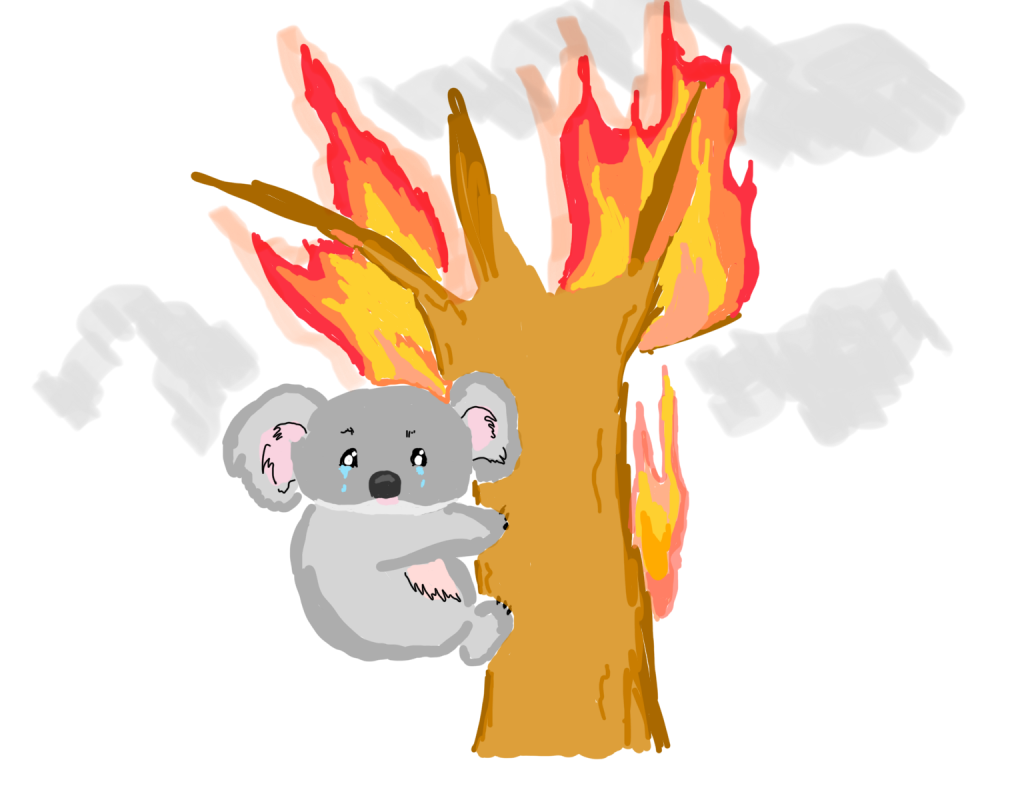The average person runs 6 miles per hour. Forest fires and grass fires can run more than 14 miles per hour. In Australia, this shocking fact has become a reality as bush fires rapidly spread nationwide, especially in its southern states, New South Wales and Victoria. The fire has been ablaze since late December and has left 26 residents dead, including three volunteer firefighters. More than 6.3 hectares of bush, forest, and parks have been cinched off the land, burning down 1,300 houses, leaving thousands homeless.
Not only are the residents in Australia affected by these bush fires but tourists from the United States are too. On December 31, the fires stormed through a popular tourist spot, Mallacoota, forcing thousands of people to take refuge on the beaches. There was no way in or out of the beach, on one side there was a black ocean covered in a layer of thick, hot, ash and on the other side, the tourists faced a wall of fire. Luckily, the fire did not reach the beach, and the Australian Navy evacuated the people just in time for no one to get hurt.
How did these fires start in the first place? Many claim that these were man-made fires. The police in Australia are accusing 24 people of deliberately setting bush fires. Others believe that they are mainly caused by Australian’s perfect weather conditions to maintain and spread a flame. Australia had the ideal combination of drought, extreme heat, wind, and lightning strikes. Finally, people are questioning if climate change is to blame. Climate change brings longer and more frequent periods of extreme heat, worsens the conditions and makes vegetation drier and more prone to burning.
These multiple factors have contributed to killing an estimate of 1.25 billion animals. Species have gone extinct, including the Eastern Bristlebird, the Mountain Pygmy Possum and the Corroboree Frog. Animals like koalas, kangaroos, wallabies are primarily killed directly from the fires, by being incinerated or by choking from the toxic smoke. More than a third of the koala species has been wiped out. Like koalas, wombats have also been hit hard, as they do not cope well with the heat of the flame and the stress that comes with it, and their small, stubby legs can not outrun the fire. Other species don’t die from the flames but from the aftermath. Smaller mammals and reptiles have no food or shelter left, leaving them vulnerable and open to certain predators like feral cats and red foxes. Australia has the highest rate of species loss of anywhere else in the world, and at this rate, the statistics of animals dying will continue to grow exponentially as the disaster continues.
Though thousands of miles away, the Austrailia fires have left a big impact on the students of Ridgewood High School. Kobe Ellenbogen, a senior, was devastated by the damage caused to the country’s animal population and forests. “I was very sad that so many koalas died.” RHS Junior carina Trama is disappointed to see the conversation around the fires disappearing from the media so quickly. “It is one of those social media trends. Now there is no one talking about the fires eventhough people and animals are still suffering.”
One way to help these animals is to spread awareness on social media to help people understand on a local level what is happening in Australia and inspire them to take action and donate. A Ridgewood High School student, Carina D’Angelo, comments, “I don’t know too much about the fires in Australia but I have seen many people spread awareness on this through social media. I am definitely concerned about this, how can I help?” There are many ways to help these creatures in danger from the fire. A few options include donating to Wildlife Information, Rescue and Education Service (WIRES) which is in New South Wales and has a mission to actively rehabilitate and preserve Australian wildlife, contributing to World Wildlife Funds which helps conserve endangered species, and getting involved with Go Fund Me for koalas to help rehydrate the koalas and treat their burns.
Lauren Shin
staff writer
Graphic: Ava Haberman

